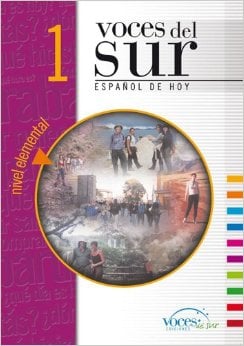When learning Spanish it’s easy to rely on tried-and-tested books and language courses. But these cookie-cutter texts from the big publishers are not always specialized enough for your needs. For example, it’s difficult to find effective learning materials for Latin American Spanish but you certainly benefit from a focus on the idiosyncrasies of Spanish spoken in this region of the world. I was given Voces del Sur by a relative in Argentina who was eager to have me learn Spanish with an Argentine accent.
Voces del Sur is published by an Argentine organization that doesn’t appear to exist anymore – the Agencia Latinoamerica de Educacion Internacional – but which worked to try and improve international relations and understanding through education. While the group may not be current, the Voces del Sur books – Beginner and Intermediate Level – remain valuable for many reasons.
First a warning or perhaps an invitation – the entire course book is written in Spanish. There are no explanations in English, and all the instructions are in Spanish. To get the best use out of this course book you need a good grounding in the language. If you know the basic grammar rules and how to construct sentences you will be able to expand on your knowledge using the exercises in the book. If you don’t already understand Spanish to this level then you will need help before tackling the work provided by Voces del Sur. The book doesn’t go into much detail explaining how to speak and write Spanish and why the grammar and vocabulary are being used.
"The entire course book is written in Spanish. There are no explanations in English, and all the instructions are in Spanish.To get the best use out of this course book you need a good grounding in the language."
The course book begins with a useful section on strategies for learning Spanish inside and outside the classroom – how to ask for the meaning of words, how to say you don’t understand, the alphabet and days of the week and month.Following this are chapters dealing with specific tasks, actions, and subjects, such as how to give information about yourself, how to express needs and wishes, how to give instructions and make plans, how to describe people, and how to talk about events in the past. Each chapter has a set of exercises. Activities include looking at an advertisement and answering questions, reading a newspaper article and talking about its contents, discussing a cartoon, and answering questions using a set of grammatical examples. The CD that comes with the book has a variety of listening exercises you can work through following the topics dealt with in the book.
Voces del Sur uses some quite advanced vocabulary to make its points. The second book in the series, Nivel Intermedio, follows the same format and uses more advanced vocabulary and more complicated examples.

Voces del Sur is firmly rooted in Buenos Aires. Examples and explanations feature Buenos Aires locations and photos, and the vocabulary examples are drawn from the Spanish spoken in Argentina’s capital city. You also get the chance to learn about Buenos Aires history and culture, for example in a section about the Madres de Plaza de Mayo and a chapter on costumes in Argentine history. Thus, the book is useful for anyone living in the city or planning a trip to Buenos Aires. It is difficult to find books with this level of specialism; the detail also makes the book more interesting and quirky.
Voces del Sur is not, however, the most current of Spanish course books. While the language used is still relevant, the pictures look dated and the layout is old-fashioned.
When I first started using the books I found it difficult to work through the exercises without help. The structure of the book is not particularly logical for a beginner and the lack of explanations can be baffling. You do need a teacher, especially as many of the exercises are spoken exercises or designed for group work. If you have an advanced level of Spanish the activities on Argentine history and culture are beneficial to advance your vocabulary and also learn more about life in this part of the world. Teachers can also use some of the exercises in the book as homework tasks or extended learning for students. But beginners will probably find the course book overwhelming – best to come back to this book with a little experience behind you.




